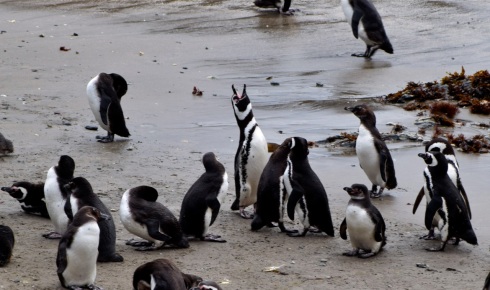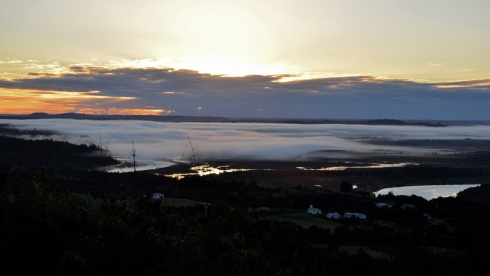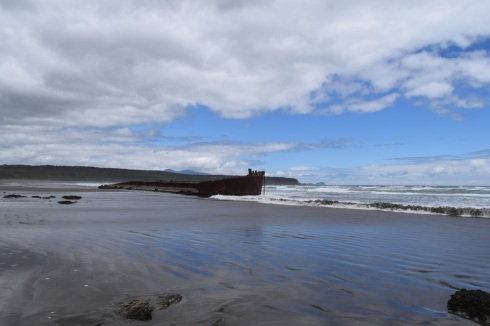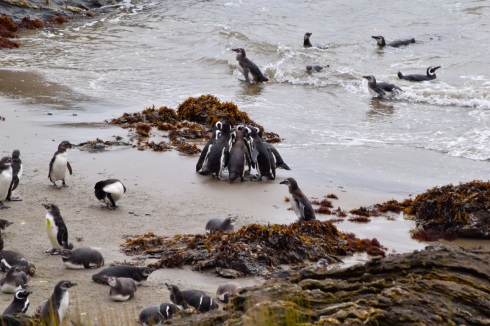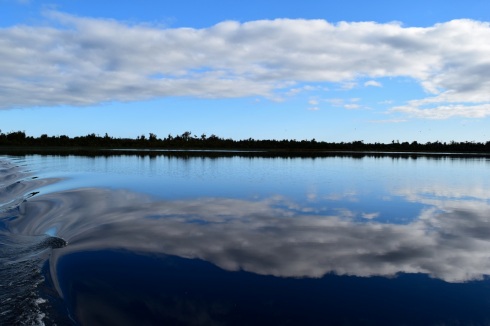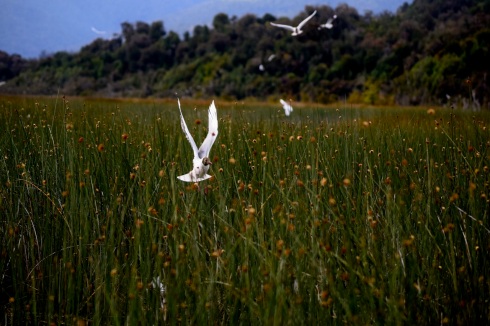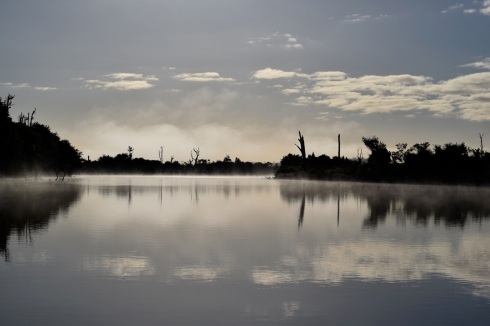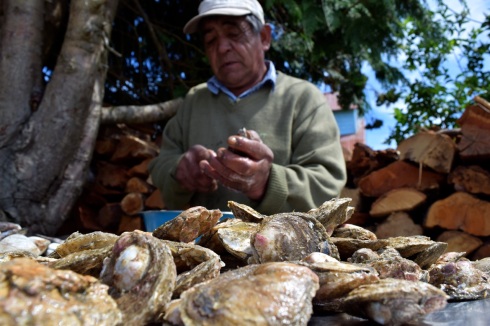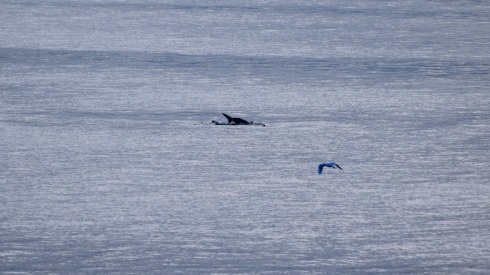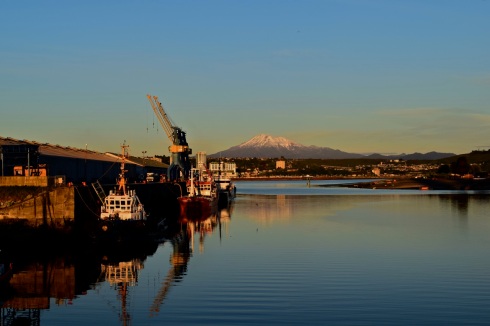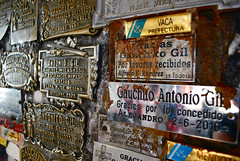Ushuaia, Argentina
[by Paula]
Last week we blogged ‘live’ from our arrival in Ushuaia, Tierra del Fuego. But there’s still some catching up to do about the places we visited on the way here, over the last month. Here’s a flashback to Chiloé, Chile, in December.
—
In these chillier climes, there are few things that can drive us out of bed at sunrise.
But given that we were in one of the most stunning parts of the Chilean island of Chiloé, where the mist hangs on the river at dawn, where the waters are teeming with birdlife, and where the best way to enjoy it is to drag your sorry buttocks outside while the day is young, we were prepared to make some exceptions.
Moreover, we’d again been blessed with some atypically fabulous weather, so it seemed like a good time to once more embrace our inner outdoorsy.
We’d made our base in rural Chepu, where an exceedingly friendly couple had allowed us to camp on their land and helped us arrange some water-based activities in the area. They had a prime hilltop spot, from which we had an amazing view of the river from the van.
On day one the water was deathly still as we took a boat across the river to a trailhead that lead to a penguin colony at Parque Ahuenco. On the way we saw kingfishers subduing their relatively large prey by thrashing around on a branch, knocking the fish senseless before swallowing it whole.
The five-hour hike passed long stretches of wild beach and peaceful forest, taking us past a massive beached shipwreck.
With it still being low season, we only saw one other person (a park employee) all day. We couldn’t have felt luckier to be able to spend an hour watching the penguins without another soul in sight. From a little viewing area about 50 metres from their colony, we were basically treated to a free slapstick comedy show. The thing about penguins is that when they’re not in the water, they really are a bit rubbish. They can’t fly and they can’t walk very well either. They trip and fall over – a lot. And that just never stops being hilarious.
We watched them huddling for little conflabs, chattering to each other, kissing, throwing their heads back and honking loudly, and playing in the water. They would climb on the rocks then slip and fall on the way down. Oops! Sometimes they would fall while just walking along on flat sand, landing on their protruding bellies and bouncing back up to carry on as if nothing had happened. Oops! As I said, it just never gets old.
We left very reluctantly, tearing ourselves away because it’s only possible to enter and exit the colony at low tide, and we were running of out time.
The following day we took a longer boat ride along the Rio Chepu to Laguna Coluco. The glassy early-morning water gave off some incredible reflections.
En route we passed through an enormous colony of nesting gulls (gaviotas cahuil, or brown-hooded gulls) who migrate to Chiloé from the north every summer. Hundreds flew overhead as we quietly puttered along, and were constantly swooping in among the reeds where they were nesting. They made a big commotion and often flew uncomfortably close to us, by way of protecting the eggs and fluffy brown chicks that were secreted nearby.
Boat trips around Chepu have an additional fascination, in that they pass through a blackened, sunken forest that lends a creepy air to the misty reflections on the water.
The valley was flooded after the 9.5-magnitude Chilean earthquake and tsunami of 1960 – the largest recorded quake of the 20th century – leaving huge sections of forest drowned in salt water.
On day three Jeremy opted for a lie-in, while I headed off on a kayak, which I’d been hankering to do for a while. Having found a pal to go with – a Norwegian woman whose husband was equally unmoved by kayaking – we set off early and pushed our boat into the misty river. It was so tranquil we felt compelled to talk only in whispers.
We had been drawn to Chiloé for all sorts of reasons. Islands so often have a cultural identity that is ferociously independent, almost rebellious against the nations they inhabit, and Chiloé is no exception. And while modern life has very much arrived here, there remains a rugged feel, where fishing still dominates, ancient traditions and beliefs endure, and community is all.
Chiloé’s famous wood-shingled architecture – including colourful ‘palafito’ homes which are raised on stilts, and a wealth of UNESCO-acclaimed churches – has probably become its most famous ‘brand’. While most remain simple family homes, smoke puffing all day from wood stoves used for cooking and heating, streets in towns like Castro have been given the shabby-chic treatment, with old houses turned into boutique hotels and organic cafes.
After leaving Chepu we spent a few days exploring the towns and villages of the northern half of the island, including a trip to sleepy Isla Quinchao – one of many islands in the Chiloé archipelago – and a few peaceful days walking in the national park.
During our nine days there, we ate out for lunch more frequently than we had done in a long time, not least because we were so thrilled about the abundance of fish and seafood and the chance to sample some distinctive local cuisine.
We slurped shellfish soups and casseroles, chowed through Chilote ‘milcao’ (a dense, usually steamed, potato cake that’s often stuffed with pork fat) and got very excited about having ‘real’ fish and chips again.
But the star of the show was Chiloé’s famous dish, curanto. We do love a challenge, and curanto is a pulse-racingly giant platter of food that – following two attempts – only one of us ever managed to complete. It’s a protein overload of giant mussels and clams, smoked pork belly, chicken, chorizo, potato and two types of milcao. In case you haven’t had enough food, or salt, a cup of strong broth is served on the side.
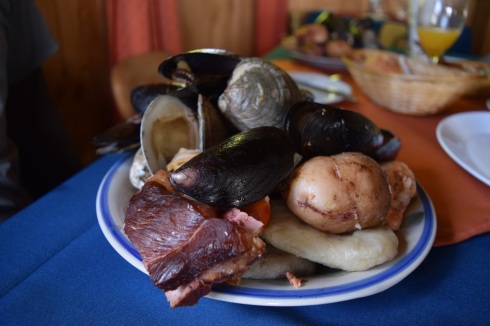
Curanto is a pulse-raising platter of giant mussels, clams, smoked pork, chorizo, chicken, potato, and two types of ‘milcao’ (dense potato cake). A cup of salty broth is served on the side.
The traditional way to cook curanto is similar to old-style Polynesian methods, involving burying the food in a shallow earth ‘oven’ of hot stones, leaves and damp cloths. It’s still used on some occasions but these days many people do the curanto in a large pot, which still follows the same method of tightly layering the food and slowly steaming it.
In the village Quetalmahue, we asked if we could watch some of the pre-Sunday lunch preparation at one of Chiloé’s well-known curanto restaurants.
On the way there we’d picked up two German hitchhikers, Rafael and Annali, and the four of us made polite faces as we were offered some raw oysters to sample. My previous memories of oysters were dominated by a sensation of gulping down seawater. I hoped I wouldn’t gag as it went down, but luckily these were delicious!
When we returned north to Ancud, the weather turned a bit colder and wetter. We’d booked a ferry from Puerto Montt to the small Chilean port of Chaiten, for a couple of days before Christmas. But we’d been continually changing our minds about what route we wanted to take after that – more of Chile or back into Argentina?
We headed to Puerto Montt and spent the day pottering around before our 10-hour overnight ferry journey. As there was no point in going to a campsite, the day included spending a long time sitting in the car looking out to sea and eating snacks. During our time around Osorno and in Chiloé we hadn’t spotted any of the promised dolphins, so were delighted to witness several large groups playing in the shallow waters right in front of the van.
So distracted were we by the dolphins, that we failed to notice a robbery directly across the road from the back of the van. The first we knew of it was when a family of Brazilian tourists started yelling, screaming and crying. Their car window had been smashed and all their luggage taken from a restaurant car park while they were inside having a meal. They came to ask us if we’d seen anything. “Not a thing! We were watching the dolphins, honest!” we protested.
We felt terrible. Also, it seemed so unlikely that we wouldn’t have noticed this happening a few feet away, that we felt a little bit under suspicion. They kept finding reasons to come back and ask more questions, while furtively looking around and inside our van. To steal four suitcases and then sit there with them in our parked car would have been audacious to say the least, but we understood their distress – losing all their stuff just two days before Christmas – so let them quietly look while saying nothing.
We eventually headed off to the ferry, and enjoyed the lovely evening with a drink on the deck.
The night was spent on uncomfortable chairs, while two lumpen pre-teens played football in the space directly front of us (under instruction from their dad), which we’d naively assumed was meant for our legs. The family had also arrived with a remote-controlled helicopter for the children to play with.
A friendly note to parents: toy helicopter + confined space + a few hundred people trying to sleep = high chance your child could be thrown overboard by a mysterious stranger. We quietly chuckled to each other when they couldn’t get it to work. Bah humbug indeed!
We docked in the morning, amid low grey skies and relentless drizzle. All the passengers lined up to disembark, while their relatives waved frantically from the dock, excited about the start of the Christmas holiday. It was then that the ferry staff announced there would be a two hour delay in getting off because the tide was too low to get the ramp down onto the jetty. This appeared to be a surprise.
No one protested, and we all shuffled back into the salon, which by now stank of the morning breath of 200 unwashed passengers. As we waited we wondered why a ferry company would have no prior knowledge of the tides!
Talking of bah humbug, we’d made no particular plans for Christmas, deciding it wasn’t important enough to particularly alter our route. Having said that, when we finally disembarked and drove into the thick mist, it confirmed something we’d been suspecting for a few days – we didn’t really fancy Christmas on a dirt road in the rain. We’d loved our detour into Chile but felt an inexplicable pull back towards Argentina.
We never really had a pre-planned route for this journey. Sometimes these decisions are made in the mood of the moment, with weather often being a major factor. Maybe it would be sunny on the other side of the border?! Maybe we could barbeque a steak?! Maybe there would be unicorns and rainbows in our Christmas stockings?!
With that, we turned east and headed for the border.
Days: 1,204
Miles: 31,249
Things we now know to be true: Penguins walk like they’re wearing someone else’s flippers.
MORE PHOTOS IN THE GALLERY BELOW:

